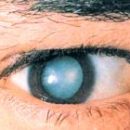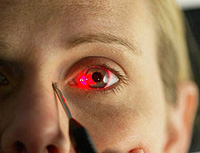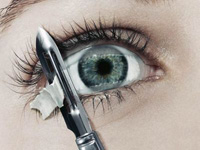Dr. Stephen Juan - an anthropologist, teacher, journalist. He knows everything about the peculiarities and oddities of our body: from the top of the heels. In his book, Stephen Juan is ready to answer all the questions of his readers; To bring facts - from those that are on a hearing, to the most amazing and unexpected. We publish a small passage from the book «Can kisses extend life? Oddities of our body and behavior», Specially provided by the Publishing site «Ripol Classic».
Content
Is it true that a man with a squint looks at the world
differently?
(Michel Durinx from Leiden, Netherlands)

Medical name Corporation - Sturdyby; It is also called heterotropy. Contrary to popular belief, the eyes of a kosying person can be directed not only inside, but also outward, that is, there is both converging and divergent squint.
Word «Strabicism» comes from the Greek word «Strabismos», Meaning «Sounding». From a medical point of view, this is a chronic disruption of parallelism of visual axes, that is, when the eyes look in different directions. Depending on these areas and distinguish the types of stabysma. In all their names, the root is noticeable «trope», Greek «Tropos», What means «turn», and the prefix determines the nature of this turn. If the eye rotates relative to the axis of another eye, then this «Cyclotropia» («Cyclos» Greatly means «a circle»). If the eyes are directed inside, then this «Esotropia»,
And if they diverge out, then «Exotropy». There are such cases when one eye is directed up («Hypertropy») or down («hypotropy»).
The direction in which the pupil eye is looking, is regulated by the muscle of the eyeball. For stabysma is characterized by inconsistency between muscles of different eyes - in this case, the eyes cannot be focused on one object and the binocular vision is disturbed. The brain cannot compare two pictures in one, and this often develops myopia or hyperopia. In infancy, the congenital squint can lead to amblyopia, that is, to the state, when the brain does not perceive the image coming from the oblique eye, although it is capable of normal vision. Sometimes the squint in children happens «false», When because of too wide bridges or a kind of cut eye to parents
It seems that the child «Kosit». This condition is called «false stabism» or «pseudo-worker». As the skull grows, the child develops, the bridge is narrowed and possible folds in the corners of the eyes are abolished. No problems with vision of such a child are not observed, although in any case it is better to see a doctor who
Put the correct diagnosis. During the test, the doctor sends a ray of light into the eye of the child and on its reflection from each of the pupils determines the direction of view for each eye.
What's worse: read in the dark or at close range?
(Leo Sanualio from Greenakra, New South Wales, Australia)
Long-term concentration of eyes in near-locked objects more harmful illumination. Dr. Michael Lowess came to this conclusion, who explains his thesis: «Under near-locked objects, items are subject to items that are closer to the distance of an elongated hand, and this implies such actions as reading, game of computer games, work on a computer and performing homework». Doctor
Lowless writes that Taiwanese researchers discovered the relationship between the long-term concentration of the eyes on the subjects close to them and the development of myopia in children. According to the study of Dr. M. BUT. Bullimore and colleagues, one of the four risk factors for the development of myopia in adults - this «For a long time, conducted by the occupation requiring a concentration of view on close objects».
If your legs performed the same work every day as your eyes, then you would have to run 80 km every day.
Some researchers believe that too tight ties men risk their eyesight.
Will the artificial eye invo?
(Leo Sanualio from Greenakra, New South Wales, Australia)
One researcher from California predicts the appearance of an artificial eye in the near future. Dr. Armand Tanguiai is currently working on creating the first implant camera for the blind. He also predicts the creation of an implant in 2014 consisting of thousands of electrodes, which will make blind to recognize faces and read the letters of 1.5 cm.
Can blind distinguish colors to the touch?
(Leo Sanualio from Greenakra, New South Wales, Australia)
German scientists puzzled one case shown on television when a kind of blind woman claimed that «see» Colors to the touch - at least she distinguished one color from another. Sorcellaneous Gabriele Simon from Wallenhorst demonstrated its abilities on the most popular German TV show Wetten
DASS. With tied eyes, feeling the fingers of an autoly and blouses, she said: «To improve your skill, it took me twenty years. This is a combination of learning and concentration. This ability allows me to choose a dress without a mother's help».
What «blindness inattention»?
Have you ever asked yourself a question: how a focusmanic manage to spend the audience, even if he tries his focus right before the eyes of some observer? No matter how strained attention, you still will not be able to notice the clever movement of the hand performing the trick. Many of us believe that if you look very closely, we will definitely note all the details. But this is not how numerous experiments of researchers argue. Dr. Daniel J. Simonz writes: «Although we intuitively believe that bright and allocated objects will definitely post our attention, very often this does not happen. For example, drivers do not notice another car while turning or a person looking free chairs in the cinema, does not notice his friend, even if he mans his hand». This phenomenon was called
«blindness inattention» or «Perceptive blindness». Some of the facts obtained during research are rather curious:
- When the subjects offered to observe the movement of blue circles across the screen and try to predict the direction of their movement, in 88% of cases tests
did not notice the change of color circles on green. - When the tests watched a video phrase in which two basketball teams transmit each other the ball and at the same time the colors of the form of one of the commands are unexpectedly changing, one of the four subjects did not notice change.
- When the subjects watched a video confirmation of a basketball game, during which a woman with an umbrella appears for 4 seconds among players on the site, one of the four subjects did not notice her.
- When the subjects looked at the two cross on the screen, trying to determine which of them more, and after three attempts on the fourth time instead of one of the crosses showed a rectangle, one of four tests also did not notice change.
To explain this phenomenon, several theories were put forward, among them the following:
- In 2005, researchers led by a doctor with. B. The bridge wrote: «The most important factor affecting the recognition process is “Personal purpose of human attention”». According to this theory, when a person looks at the basketball game and at the same time sincerely interested in the game, he is less inclined to notice the girl in a bikini standing on the side line with a big sign in the form of a heart in her hands.
- Based on experiments conducted in 2006, Researchers Mika Koivisto and Anti Revissuo suggested: the more new it seems that we are already witnessing, the stronger our ability to recognize this new phenomenon. It would seem that completely unexpected things, on the contrary, would have to attract more attention,
But it is not. This is told by the tests themselves. So no magic is not here -
Simple psychological factor.
Why the photo list blinds?
(Joe Walker from Longville, New South Wales, Australia)
The light of the flash is so like that he for a while «Overloads» Light-sensitive wand and mesh wet. Even after returning the ability to vie, the flash effect is saved for a while. To a lesser extent, the same happens if you get out of the dark cinema on bright street light. The eye has an amazing ability to adapt to various lighting, but for this he is required from a few seconds to several minutes. As Dr. Kenton Makulyams writes, on average, human
The eye is fully adjusted to a significant change in the lighting in about 25 minutes.
Why under water is better visible in swimming glasses?
(Joe Walker from Longville, New South Wales, Australia)
Probably, each of you noticed that a spoon placed in a glass with water seems curved. When the rays of light go from one medium (for example, air) to another (for example, in water), they change their speed. In water, the light moves at a lesser rate than in the air, and as a result, the beam of light changes its direction. This is a phenomenon
called «refraction». The degree of refraction depends on the ratio of light speed in each of the media.
The human eye is arranged in such a way that the rays of the light entering it through the pupil, focused on the retina located on the back wall of the eye. At the same time, it is adapted for vision in an air, and not aquatic environment, because throughout its history, people spent much more time on land than in water. Under water the same angle between the rays in the water and the refracted rays inside the eye are somewhat different, so they do not focus where it is necessary. Putting on glasses, man returns to the combination habitual for him «Air - eye», so due to this is restored normal
vision. The phenomenon of the refraction of light on the border of two media is used in such devices such as glasses and contact lenses. Lenses refracted the light so that it falls on the retina at the right angle - thereby it is possible to adjust the vision at myopia or hyperopia. Of course, focusing depends not only on
how the rays come into the eye. The focusing ability of the eye depends on the eyelic muscles of the eye arranged around the age and eyelashes.









